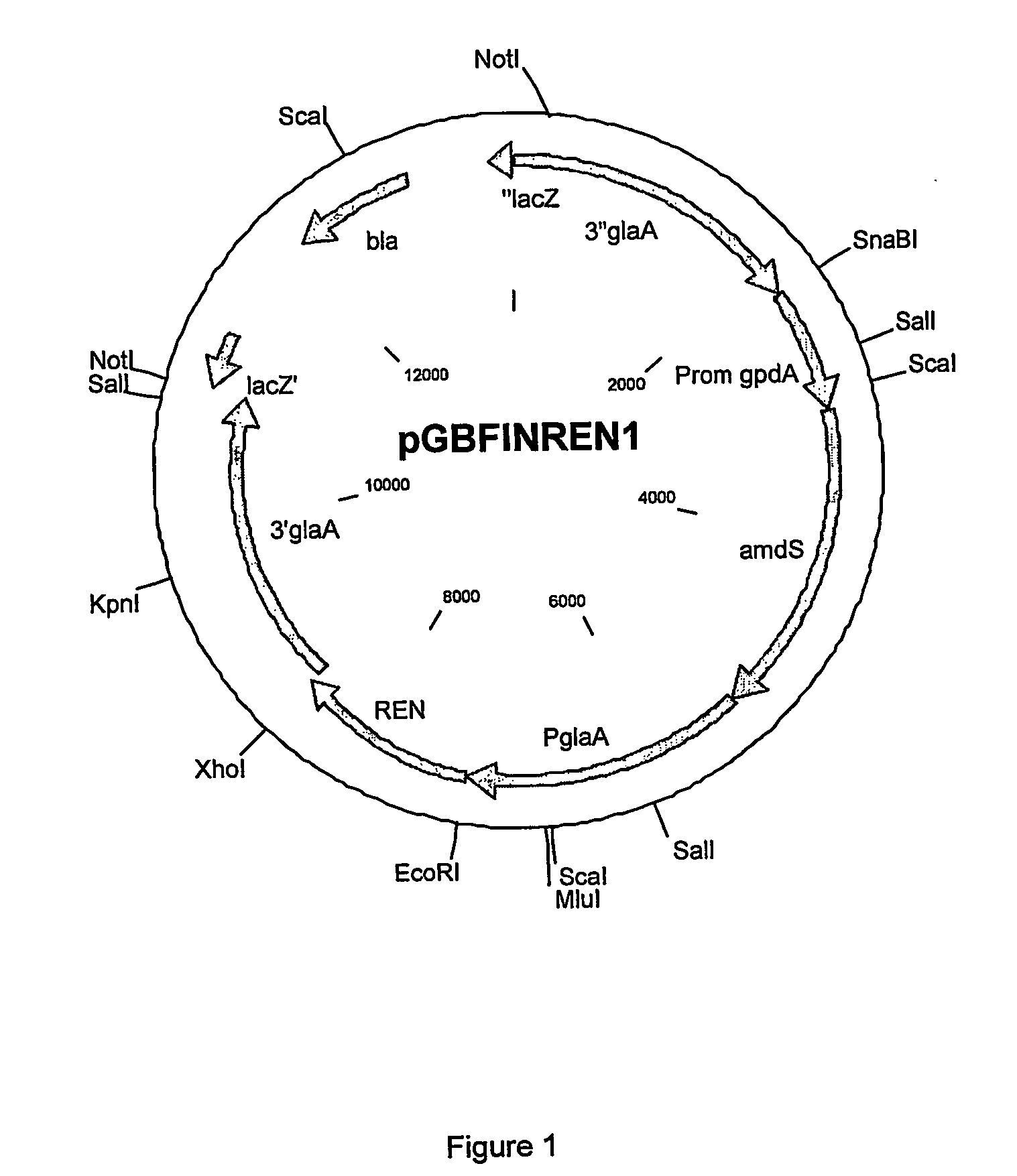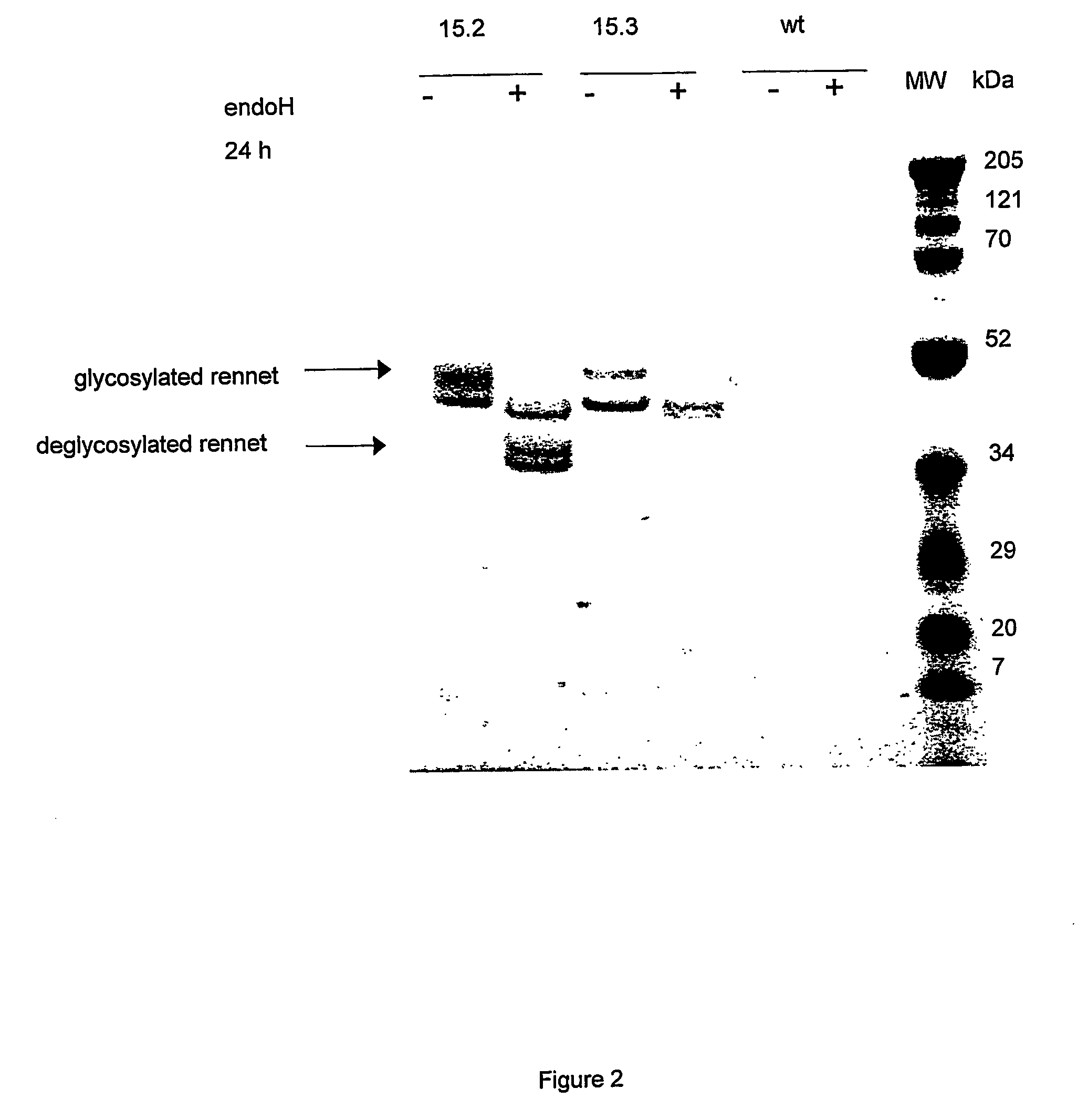Rennets
a technology of clotting enzymes and rennets, which is applied in the field of new milk clotting enzymes, can solve the problems of low cheese yield, inability to adapt to the structure and taste of the resulting cheese, and the application of few proteases in chees
- Summary
- Abstract
- Description
- Claims
- Application Information
AI Technical Summary
Problems solved by technology
Method used
Image
Examples
example 1
Identification of a Rennet from Aspergillus niger
[0074] The sequenced genome of Aspergillus niger contains many genes encoding aspartic proteases. However it was unclear if any a specific aspartic protease would be useful as rennet in cheese making applications. Here we propose that aspartic proteases containing the peptide motif FDTGSSD / E would be preferably suitable for the use in milk coagulation and cheese ripening.
[0075] Using the peptide motif FDTGSSD / E the sequenced and annotated genome of Aspergillus niger CBS513.88 was screened for the presence of a gene encoding an aspartic protease that might be suitable as rennet in cheese production.
[0076] Of the many genes encoding aspartic proteases in the Aspergillus niger genome, only one gene was identified using the screening with the rennet motif described above. The DNA sequence of this gene is depicted in SEQ ID NO:1. The open reading frame, deduced from the DNA sequence is depicted in SEQ ID NO:2, and the protein sequence d...
example 2
Identification of Rennets in Other Species
[0077] A person skilled in the art will appreciate that the present invention can be applied to the identification of rennets from other species. Most convenient, a computer aided search of the DNA- and / or protein-databases is performed. For this specific purpose useful programs are available in the public domain. The internet site http: / / www.ncbi.nlm.nih.gov / blast / Blast.cgi provides the possibility of searching public domain DNA- and / or protein-sequences using the BLAST programs. A search was done using the BLASTP2.2.1 program, a wordsize of 3, no filter, the BLOSUM62 matrix, gapcosts-existence of 11, and extension 1. The peptide motif FDTGSSD was used, and a comparison was done with the non-redundant Genbank CDS translations+PDB+Swissprot+PIR+PRF sequence databases, of Oct. 1, 2001. Obviously a similar search can be performed with the motif FDTGSSE. For a search in such a large database it is relevant to put the expect threshold at 15,000...
example 3
Isolation of Genes Encoding Rennets, When the DNA Sequence is Unknown.
[0080] Using this peptide sequence motif, it is also possible to isolate genes encoding rennets when the gene sequence is unknown. Methods have been described in literature to design degenerate oligonucleotide primers that can be used for this purpose (Sambrook et al. (1989) Molecular cloning: a laboratory manual. Cold Spring Harbor Laboratory Press). Also, methods to isolate genes from an organism, using a degenerate oligonucleotide as probe or primer, have been described.
[0081] Oligonucleotides that code for the peptide motif FDTGSSD / E are useful for isolation of the genes encoding aspartic proteases with rennet properties will. The sequences of these oligonucleotides is 5′-TTYGAYACNGGNTCNTCNGA-3′, 5′-TTYGAYACNGGNTCNAGYGA-3′, 5′-TTYGAYACNGGNAGYTCNGA-3′or 5′-TTYGAYACNGGNAGYAGYGA-3′ where Y=T or C and N=A or G or T or C (SEQ ID NO's: 6-9). Other useful oligonucleotides for screening for genes encoding rennets, a...
PUM
| Property | Measurement | Unit |
|---|---|---|
| pH | aaaaa | aaaaa |
| pH | aaaaa | aaaaa |
| Nucleic Acid | aaaaa | aaaaa |
Abstract
Description
Claims
Application Information
 Login to View More
Login to View More - Generate Ideas
- Intellectual Property
- Life Sciences
- Materials
- Tech Scout
- Unparalleled Data Quality
- Higher Quality Content
- 60% Fewer Hallucinations
Browse by: Latest US Patents, China's latest patents, Technical Efficacy Thesaurus, Application Domain, Technology Topic, Popular Technical Reports.
© 2025 PatSnap. All rights reserved.Legal|Privacy policy|Modern Slavery Act Transparency Statement|Sitemap|About US| Contact US: help@patsnap.com



